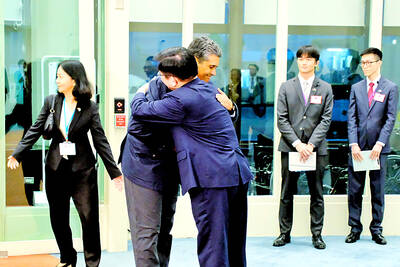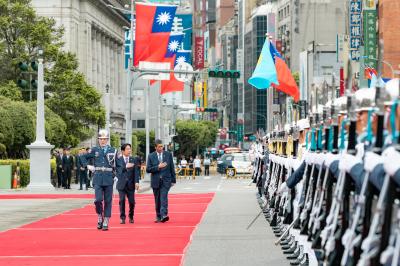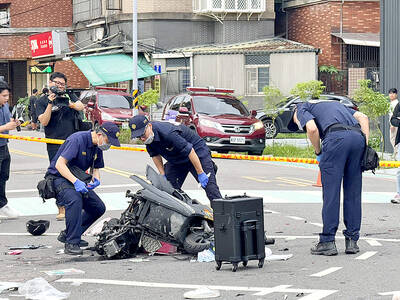It is ironic that while no trace of late dictator Chiang Kai-shek (蔣介石) can be found in the 228 Memorial Museum, his image can be seen everywhere on NT$10 coins, Democratic Progressive Party Legislator Pasuya Yao (姚文智) said yesterday, demanding that all coins bearing Chiang’s image be recalled.
The 228 Incident refers to the bloody crackdown on protesters under Chiang’s administration after a woman was beaten for selling contraband cigarettes in Taipei on the night of Feb. 27, 1947.
Yao, a former Government Information Office minister, proposed changing Chiang’s image on the coins to images of people who contributed positively to Taiwanese society like victims of the Incident, such as internationally renowned painter Chen Cheng-po (陳澄波).
In 2006, the 228 Incident Memorial Foundation’s published a report titled Who Should Shoulder Responsibility for the 228 Incident? that said “Chiang was the instigator of the Incident and should shoulder most of the responsibility,” Yao said, adding that other historical sources confirmed that Chiang was responsible for the Incident.
However, Yao said that a design featuring Chiang’s image was introduced in 1981 for NT$10 and NT$5, adding that coins bearing the images of Chiang Wei-shui (蔣渭水), an important figure in Taiwan’s resistance against Japanese colonial rule, and late president Chiang Ching-kuo (蔣經國), Chiang Kai-shek’s son, accounted for just 3.4 percent of the 2.9 billion Taiwanese coins in circulation.
These 30-year-old coins are not only nearing the time when they should be phased out, but Taiwan is also currently strengthening its democracy and transitional justice, which should not be limited to memorial museums and memorial services, while the instigator of the Incident still haunts our daily lives, Yao said.
The central bank should recall all coins with the image of the 228 Incident instigator on them and issue new coins with the image of 228 victims like Chen, Yao said, adding that in the future, other important figures or stories should also be considered candidates for images on coins.
In terms of choosing the images of personages on coins, Yao said that countries across the world have begun to substitute artists or members of other professional careers for political figures to reflect the dynamic characteristic of their nations, citing the example of New Zealand’s NZ$5 note, featuring Edmund Hillary, the first person in the world to climb Mount Everest, and the Japanese ¥1,000 note, using the image of Noguchi Hideyo, who was nominated for the Nobel Prize in Physiology or Medicine three times.
When other nations use the images of political figures on their money, they choose those with highly positive values, such as former US presidents George Washington and Abraham Lincoln, Yao said, adding that none chose a controversial symbol of authoritarian rule like Chiang Kai-shek.
Translated by Jake Chung, Staff Writer

Palauan President Surangel Whipps Jr arrived in Taiwan last night to kick off his first visit to the country since beginning his second term earlier this year. After arriving at Taoyuan International Airport at around 6:30 pm, Whipps and his delegation were welcomed by Minister of Foreign Affairs Lin Chia-lung (林佳龍). Speaking to gathered media, the Palauan leader said he was excited and honored to be back in Taiwan on his first state visit to Taiwan since he was sworn in this January. Among those traveling with Whipps is Minister of State Gustav N. Aitaro, Public Infrastructure

President William Lai (賴清德) yesterday thanked Palau for its continued support of Taiwan's international participation, as Taipei was once again excluded from the World Health Assembly (WHA) currently taking place in Switzerland. "Palau has never stopped voicing support for Taiwan" in the UN General Assembly, the WHO and other UN-affiliated agencies, Lai said during a bilateral meeting with visiting Palau President Surangel Whipps Jr. "We have been profoundly touched by these endorsements," Lai said, praising the Pacific island nation's firm support as "courageous." Lai's remarks came as Taiwan was excluded for the ninth consecutive year from the WHA, which is being held in

RESOLUTIONS DEBATE: Taiwan’s allies said that UN and WHA resolutions cited by China and other nations ‘do not determine Taiwan’s participation in WHO activities’ A proposal to invite Taiwan to this year’s World Health Assembly (WHA) was rejected on Monday, resulting in Taipei’s absence from the annual meeting for a ninth consecutive year, although partners spoke up for Taiwan’s participation at the first day of the meeting. The first agenda item after the opening was a “two-on-two debate” on a proposal to invite Taiwan to participate at the WHA as an observer. Similar to previous years, two countries made statements in favor of the proposal, while two others expressed their opposition. Philippine Secretary of Health Teodoro Herbosa, president of the 78th WHA, accepted the WHA General Committee’s

At least three people died and more than a dozen were injured yesterday afternoon when a vehicle struck a group of pedestrians in New Taipei City’s Sansia District (三峽). The incident happened at about 4pm when a car rammed into pedestrians at an intersection near Bei Da Elementary School. Witnesses said the sedan, being driven at a high speed, ran a red light, knocking scooters out of the way and hitting students crossing the road before careening into a median near the intersection of Guocheng and Guoguang streets. The incident resulted in three deaths and 13 injuries, including the driver, a 78-year-old man